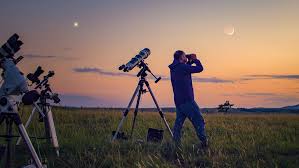Telescopes are powerful instruments that allow us to observe distant celestial objects. They have played a crucial role in our understanding of the universe and have enabled us to make groundbreaking discoveries.
Types of Telescopes
There are two main types of telescopes:
- Optical Telescopes: These telescopes use lenses or mirrors to collect and focus visible light. Optical telescopes can be ground-based or space-based.
- Radio Telescopes: These telescopes detect radio waves, which are a form of electromagnetic radiation. Radio telescopes are often used to study distant galaxies, nebulae, and black holes.
Key Components of a Telescope
- Aperture: The size of the telescope’s main lens or mirror. A larger aperture allows the telescope to collect more light, which results in a brighter and clearer image.
- Mount: The mechanism that supports the telescope and allows it to be pointed in different directions.
- Optics: The lenses or mirrors that focus the light collected by the telescope.
- Detectors: The devices that convert the light collected by the telescope into electrical signals.
Famous Telescopes
Some of the most famous telescopes in history include:
- The Hubble Space Telescope: This space-based telescope has made major contributions to our understanding of the universe. It has observed distant galaxies, nebulae, and exoplanets.
- The Very Large Telescope (VLT): This ground-based telescope is located in Chile and is one of the most powerful optical telescopes in the world.
- The Arecibo Observatory: This radio telescope is located in Puerto Rico and is one of the largest single-dish telescopes in the world.
The Future of Telescopes
Telescopes continue to evolve, with new technologies and designs being developed all the time. Future telescopes may be even larger and more powerful than anything we have seen before. They could help us to answer some of the biggest questions in astronomy, such as the nature of dark matter and dark energy.
Telescopes are essential tools for exploring the universe. They allow us to see things that are invisible to the naked eye and to learn more about the nature of reality. As technology continues to advance, we can expect to see even more exciting discoveries made with telescopes in the future.
